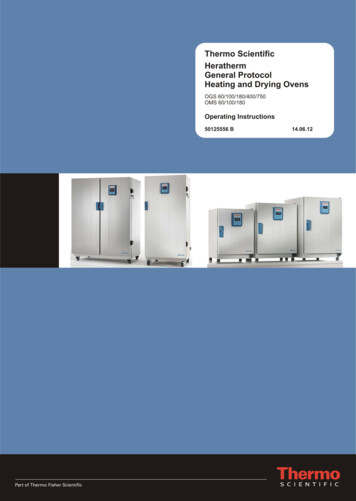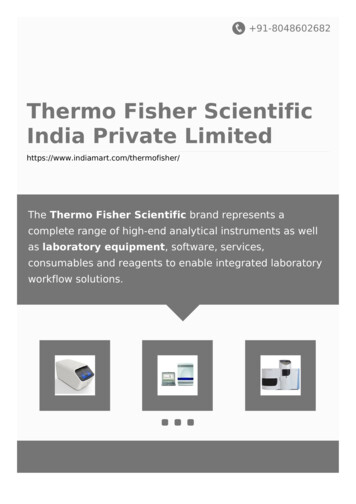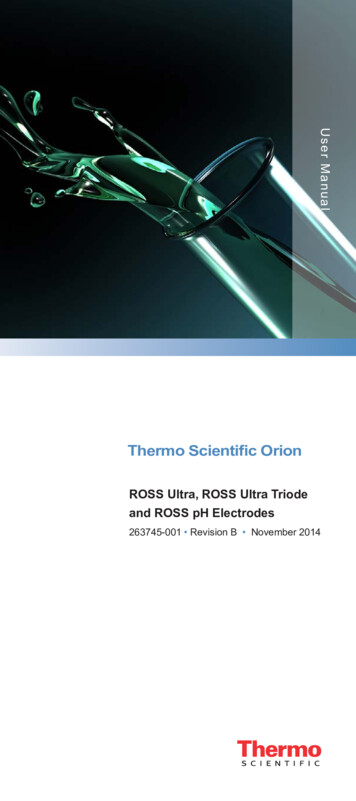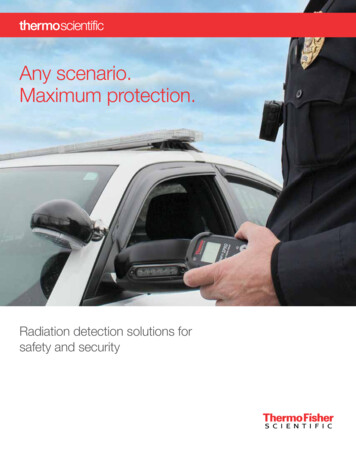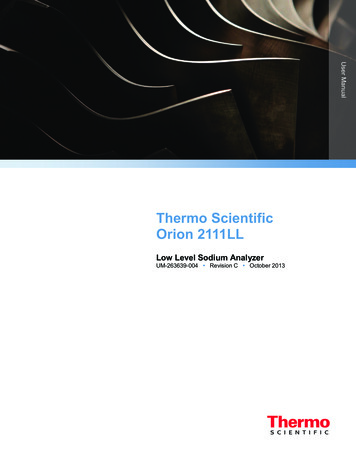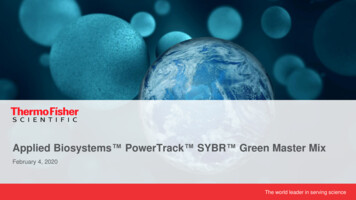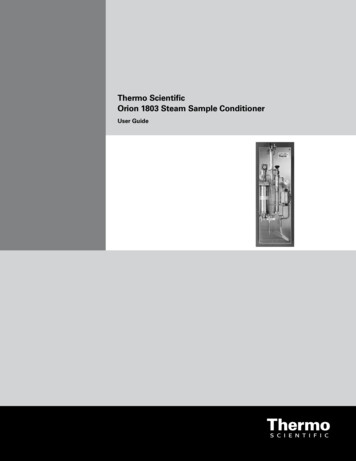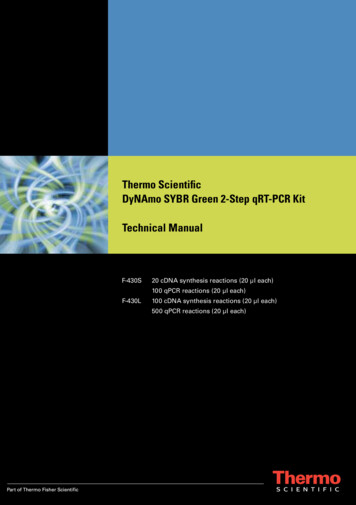
Transcription
Thermo ScientificDyNAmo SYBR Green 2-Step qRT-PCR KitTechnical ManualF-430S20 cDNA synthesis reactions (20 µl each)100 qPCR reactions (20 µl each)F-430L100 cDNA synthesis reactions (20 µl each)500 qPCR reactions (20 µl each)
Table of contents1. Description. 42. Kit components. 53. Shipping and storage. 54. cDNA synthesis. 54.1 Notes about reaction components. 54.2 Reaction setup . 84.3 cDNA synthesis steps. 105. qPCR. 115.1 Notes about reaction components. 115.2 Reaction setup. 135.2.1 General protocol for all instruments. 145.2.2 Protocol for Applied Biosystems real-time PCRinstruments requiring ROX. 176. Analysis. 186.1 Melting curve. 186.2 Absolute quantification. 186.3 Relative quantification. 187. Troubleshooting. 19Appendix I: general molecular biology data. 22Product use limitation. 23Trademark and patent notices; label licenses. 232
1. DescriptionQuantitative PCR (qPCR) is a useful technique for the investigation of gene expression,viral load, pathogen detection, and numerous other applications. When analyzing geneexpression or viral load, the RNA of interest first needs to be reverse transcribed into cDNA.The following qPCR can either be performed separately (two-step qRT-PCR) or in the sametube with reverse transcription (one-step qRT-PCR).Thermo Scientific DyNAmo SYBR Green 2-Step qRT-PCR Kit is designed for two-stepqRT-PCR of RNA samples from various sources. The kit includes all the necessary reagentsfor cDNA synthesis and following SYBR Green qPCR. Either total RNA, messenger RNA,viral RNA or in vitro transcribed RNA can be used as a template for reverse transcription.The kit includes both random primers and oligo(dT) primers. The user can choose either ofthese or alternatively use gene specific primers.The reverse transcriptase in the DyNAmo SYBR Green 2-Step qRT-PCR Kit is M-MuLVRNase H , which provides higher sensitivity to qPCR than RNase H- reverse transcriptases.The RNase H activity in the RT enzyme facilitates annealing of PCR primers to the cDNAby degrading the RNA template before the PCR step.The performance of the qPCR step is based on a hot start version of a modified Thermusbrockianus (Tbr) DNA polymerase and SYBR Green I fluorescent dye. A nonspecific DNAbinding domain has been fused to the Tbr DNA polymerase. The domain lends physicalstability to the polymerase-DNA complex. The initial denaturation step in the PCR protocolactivates the modified hot-start Tbr polymerase. SYBR Green I is specific for doublestranded DNA and fluoresces when bound to the amplified double-stranded PCR product,thereby permitting the direct quantification of amplified DNA without labeled probes.The reaction chemistry of DyNAmo SYBR Green 2-Step qRT-PCR Kit is applicable tomost block-based real-time PCR instruments, including those from Applied Biosystems,Bio-Rad Laboratories, Corbett Research, and Stratagene. For capillary-based instruments,such as the Roche LightCycler , we recommend Thermo Scientific DyNAmo CapillarySYBR Green 2-Step qRT-PCR Kit (F-440).3
2. Kit componentscDNA synthesisF-430SF-430LM-MuLV RNase H reverse transcriptase (includesRNase inhibitor)1 x 40 µl(sufficient for 20 RT reactionsof 20 µl)1 x 200 µl(sufficient for 100 RTreactions of 20 µl)2x RT buffer (includes dNTP mix and 10 mM MgCl2*)1 x 200 µl1 x 1 mlRandom hexamers (300 ng/µl)1 x 20 µl1 x 100 µlOligo(dT)15 primer (100 ng/µl)1 x 20 µl1 x 100 µlqPCRF-430SF-430L2x master mix (contains modified hot-start TbrDNA polymerase, SYBR Green I, optimized PCRbuffer, 5 mM MgCl2**, dNTP mix including dUTP)1 x 1 ml(sufficient for 100 reactions of20 µl or 40 reactions of 50 µl)5 x 1 ml(sufficient for 500 reactions of20 µl or 200 reactions of 50 µl)50x ROX passive reference dye1 x 50 µl1 x 250 µl* Provides 5 mM MgCl2 in 1x reaction concentration** Provides 2.5 mM MgCl2 in 1x reaction concentrationMaterial safety data sheet (MSDS) is available at www.thermoscientific.com/fzmsds.3. Shipping and storageThe DyNAmo SYBR Green 2-Step qRT-PCR Kit is shipped on gel ice. Upon arrival, storeall kit components at -20 C. All the kit components can be refrozen and stored at -20 Cwithout affecting the performance of the kit.4. cDNA synthesis4.1 Notes about reaction componentsTable 1. General recommendations.4CategoriesCommentsReaction volume20 µlTemplate amountMax 1 µg of RNA.Priming optionsRandom hexamers, oligo(dT) or gene-specific primers.
RNA templateTotal RNA, mRNA, viral RNA or in vitro transcribed RNA can be used as a template.Successful cDNA synthesis is dependent on the integrity and purity of the template RNA.RNA preparation should be free of any DNA or RNase contamination. The purity of RNAcan be determined by measuring the ratio of A260/A280. The optimal ratio is 1.8–2.0.RNA isolation should be performed under RNase-free conditions. Furthermore, anycontamination with RNases from other potential sources like glassware, plasticware andreagent solutions has to be avoided. This can be done by wearing gloves and using steriletubes and pipet tips. Water used for the reactions should also be RNase free, but not DEPCtreated as traces of DEPC can inhibit PCR.DNA contamination can be removed from the RNA sample by treating the sample withRNase free DNase I. This should be done especially if primers for the qPCR step cannotbe designed in exon-exon boundaries or in separate exons. See information about qPCRprimer design in Section 5.1.The maximum amount of template RNA for DyNAmo SYBR Green 2-Step qRT-PCR Kitis 1 µg. This amount includes all RNA present in the sample, for example carrier RNA andother possible RNAs in addition to the target RNA.M-MuLV RNase H reverse transcriptaseM-MuLV RNase H RT provides good sensitivity in qRT-PCR applications, where ampliconsare usually around 100 bp in length. Also, with M-MuLV RNase H there is no need toperform separate RNase H treatment after cDNA synthesis, as the RNase H activity in theenzyme degrades RNA in the RNA-cDNA hybrid.RNase inhibitorThe RNase inhibitor included in the mix with the reverse transcriptase inhibits contaminatingRNases present in the RNA sample. It does not affect the RNase H activity in the M-MuLVreverse transcriptase.RT primersSpecific primers, random hexamers or oligo(dT) primers can be used for the RT step.Using specific primers can help to decrease background, whereas random hexamers andoligo(dT) primers are useful if several different amplicons need to be analyzed from a smallamount of starting material.A good starting point is to use random hexamers for cDNA synthesis. Random hexamerstranscribe all RNA (mRNA, rRNA, tRNA and in vitro transcribed RNA) producing cDNA thatcovers the whole transcript. The recommended amount of random hexamers per 20 µl RTreaction is 300 ng (can be optimized between 200–400 ng if necessary).Oligo(dT) primers can be used to transcribe poly(A) RNAs. These include eukaryotic5
mRNAs and retroviruses with poly(A) tails. Several different mRNAs are transcribedallowing subsequent qPCR detection of different targets from the same cDNA synthesisreaction. The recommended amount of oligo(dT) primers per 20 µl RT reaction is 100 ng(can be increased up to 1 µg if necessary). If the amplicon is located at the 5’ end of thetranscript, using random hexamers is recommended.Gene-specific primers are used to transcribe only the particular RNA of interest, incontrast to oligo(dT)/random primers that transcribe all mRNAs/RNAs in the sample. Therecommended amount of specific primer per 20 µl RT reaction is 10 pmol (can be optimizedbetween 5–20 pmol if necessary).Minus RT controlA minus RT control should be included in all qRT-PCR experiments to test for DNAcontamination (such as genomic DNA or PCR product from a previous run). Such a controlreaction contains all the reaction components except for the reverse transcriptase. RTreaction should not occur in this control, so if PCR amplification is seen, it is most likelyderived from contaminating DNA.RT efficiencyThe cDNA synthesis step is very critical in qRT-PCR. The efficiency of reverse transcriptionvaries and can be low in some cases. The expression level of the target RNA moleculeand the efficiency of the RT reaction must therefore be considered when determining theappropriate amount of starting template for subsequent PCR steps. The volume of cDNAtemplate should not exceed 10 % of the qPCR reaction volume, as elevated volumesof template may reduce the efficiency of the PCR amplification. A dilution series of thetemplate can be done to optimize the volume of the starting material used.StandardsThe absolute amount of the target nucleic acid (expressed as a copy number or concentration)is determined by comparison of Cq values to external standards containing a known amountof nucleic acid. (Cq quantification cycle, the fractional PCR cycle at which the target isquantified in a given sample. The level of Cq is set manually or calculated automatically.) Theexternal standards should contain the same or nearly the same sequence as the templateof interest. It is especially important that the primer binding sites are identical to ensureequivalent amplification efficiencies of both standard and target molecules.Using RNA molecules as standards for RNA quantification is recommended. The useof RNA standards takes the variable efficiency of the reverse transcription into account.RNA standards can be generated for example by cloning the cDNA of interest to a vectorcontaining RNA polymerase promoter, e.g. T7 or Sp6. From the vector the insert canbe in vitro transcribed to obtain the final RNA standard with identical sequence to the6
target amplicon. The vector must then be degraded with RNase-free DNase, and theconcentration of the RNA standard determined spectrophotometrically. Alternatively adefined RNA preparation, e.g. from a cell line or a virus, with known concentration can beused as an RNA standard.Reference genesWhen studying gene expression, the quantity of the target gene transcript needs to benormalized against variation in the sample quality and quantity between samples. To ensureidentical starting conditions, the relative expression data have to be normalized with respectto at least one variable, such as sample size, total amount of RNA, or reference gene(s),for example. A gene used as a reference should have a constant expression level that isindependent of the variation in the state of the sample tissue. Examples of commonlyused reference genes are beta actin, GAPDH and 18S rRNA. A problem is that, even withhousekeeping genes, the expression usually varies to some extent. That is why severalreference genes are usually required, and their expression needs to be checked for eachexperiment.The amplification efficiency of a reference gene should be the same as the amplificationefficiency of the target gene, i.e. the slopes of their standard curves should be identical. Ifthis is not the case, the results have to be corrected for the efficiency.Since RNA quantification involves a number of variables, and each experiment isinherently different, careful experimental design is very important. Useful information andguidelines for experimental design, normalization, RNA standards, etc. can be found in thefollowing review articles:Bustin S.A. (2000) Journal of Molecular Endocrinology 25, 169–193Bustin S.A. (2002) Journal of Molecular Endocrinology 29, 23-39.4.2 Reaction setup Perform the reaction setup in an area separate from nucleic acid preparation andPCR product analysis. All plasticware should be RNase-free. Use gloves to prevent RNase contamination. Pipette with sterile filter tips. Minimize pipetting errors by using calibrated pipettes and by preparing premixes toavoid pipetting very small volumes. Pipet all components on ice. Reaction tubes should be centrifuged before starting the incubations to force thesolution to the bottom of the tubes and to remove any bubbles.7
Protocol1. Program the cycler as outlined in Table 3.2. Thaw template RNA, 2x RT buffer and primers. Mix the individual solutions to ensurehomogeneity.3. Prepare a cDNA synthesis premix by mixing 2x RT buffer, primers, RNase free H2O andreverse transcriptase (see Table 2). Mix thoroughly to ensure homogeneity. Dispenseappropriate volumes into reaction tubes.4. Add template RNA to the reaction tubes.5. Place the tubes in the thermal cycler and start the program.Table 2. Reaction setup for cDNA synthesis.ComponentsStock20 µl reactionCommentsRT buffer2x10 µlRT buffer includes dNTPs and MgCl2Random hexamer primer set300 ng/µl1 µlAlternatively oligo(dT) primer or aspecific primer can be used. SeeSection 4.1 (‘RT primers’).Template RNAX µlMax 1 µg.M-MuLV RNase H reverse transcriptase2 µlIncludes RNase inhibitor.RNase free H2Oadd to 20 µlTable 3. Cycling protocol for reverse Primerextension25 C10 minThis step is not necessary if gene specific primers are used.2cDNAsynthesis37 C30 minMost targets can be synthesized at 37 C. The temperature canbe varied between 37–48 C if necessary. Incubation time canbe extended up to 60 min if needed for long or rare transcripts.3Reactiontermination85 C5 minInactivation of M-MuLV prevents it from inhibiting qPCRreaction.4Cooling thesample4 CHoldOptional
4.3 cDNA synthesis stepsPredenaturation (optional)A separate RNA denaturation step is generally not required, but it can be performedbefore cDNA synthesis if the template RNA has a high degree of secondary structure. Thedenaturation step, at 65 C for 5 min, should be performed before adding 2x RT buffer andreverse transcriptase to the reaction mix.Primer extensionThe incubation at 25 C for 10 min extends random primers or oligo(dT) primers before theactual cDNA synthesis. Without the incubation at 25 C the primers may dissociate fromthe template when the temperature is raised to the cDNA synthesis temperature. Thispreliminary extension step is not necessary for gene-specific primers.cDNA synthesisIncubation at 37 C will work for most templates, but it can be optimized between 37 Cand 48 C if necessary. Raising the temperature can be helpful if the template has strongsecondary structures. Higher temperature can also improve specificity if gene-specificprimers are used. Incubation time of 30 min is sufficient in most cases. If the target islocated near the 5’ end of a long transcript and oligo(dT) priming is used, or the target israre, cDNA synthesis time can be extended up to 60 min.Reaction terminationThe termination step at 85 C inactivates the M-MuLV reverse transcriptase, thus preventingit from inhibiting the qPCR reaction.9
5. qPCR5.1 Notes about reaction componentsTable 4. General recommendations for qPCR.CategoriesCommentsConsumablesFollow the recommendations of the PCR instrument manufacturer.Reaction volume20–50 µlAmplicon size50–250 bpTemplate amountThe volume of cDNA template should not exceed 10 % of the qPCR reaction volume.Primer designUse primers with matched Tm. Avoid inter-primer and intra-primer complementarysequences. We recommend calculating Tm by the nearest-neighbor method as described byBreslauer et al. (1986) Proc. Nat. Acad. Sci. 83, 3746-50. Instructions for Tm calculation anda link to a calculator using a modified nearest-neighbor method can be found on the ThermoScientific website (www.thermoscientific.com/pcrwebtools).MgCl21x master mix contains 2.5 mM MgCl2, and can be optimized up to 5 mM.cDNA templateIf the cDNA synthesis reaction will not be used for qPCR immediately, it can be stored at -20 C.Also, if only part of the reaction volume is needed for qPCR, store the remainder at -20 C.The volume of cDNA template should not exceed 10 % of the qPCR reaction volume, aselevated volumes of template may reduce the efficiency of the PCR amplification. Excesssalt and random primers in the cDNA synthesis reaction can inhibit the DNA polymerase.A dilution series of the template can be made to optimize the amount of the startingmaterial used.DNA polymeraseThe 2x qPCR master mix in the DyNAmo SYBR Green 2-Step qRT-PCR Kit includes a hotstart version of a modified Thermus brockianus DNA polymerase. The modified polymeraseincorporates a nonspecific DNA binding domain that lends physical stability to the polymeraseDNA complex. The modified Tbr polymerase is chemically engineered to be inactive at roomtemperature. The inactivation prevents the extension of non-specifically bound primers duringreaction setup and therefore increases PCR specificity. The reaction setup can be performed atroom temperature. The initial denaturation step in the PCR protocol reactivates the polymerase(hot start).10
Primers for qPCR stepCareful primer design is particularly important to minimize nonspecific primer annealing andprimer-dimer formation, since fluorescence from SYBR Green I increases strongly uponbinding to any double-stranded DNA. Standard precautions must be taken during primerdesign to avoid primer-dimer or hairpin loop formation. Most primer design software toolswill yield well-designed primers for use in qPCR. In most cases, good results are obtainedusing a concentration of 0.5 µM for each primer. The optimum primer concentration isusually between 0.3 and 1 µM.PCR primers in qRT-PCR experiments should be designed to anneal to sequences in twoexons on opposite sides of an intron. A long intron inhibits the amplification of the genomictarget. Alternatively, primers can be designed to anneal to the exon-exon boundary of themRNA. With such an assay design, the priming of genomic target is highly inefficient.ROX passive reference dyeFor most real-time instruments ROX passive reference dye is not required, but on someinstruments it is used to normalize for non-PCR related fluorescence signal variation.Passive reference dye does not take part in the PCR reaction and its fluorescence remainsconstant during the PCR reaction. The amount of the ROX passive reference dye neededcan vary depending on the type of the excitation. The amount of ROX dye needed with realtime cyclers which use argon laser as the excitation light source or which have excitationfilters that are not optimal for ROX dye may be greater than with instruments that exciteefficiently near 585 nm.The ROX dye is provided as a 50x solution dissolved in a buffer that is compatible with theqPCR reaction buffer. The optimal ROX dye concentration is usually 0.3–1x (see Table 5 forinstrument-specific recommendations). Note that the use of ROX passive reference dyemay not be possible with some fluorescent dyes.Table 5. ROX concentration.Real-time PCR instrumentRecommended ROX concentrationApplied Biosystems StepOne Real-Time PCR System1xApplied Biosystems 7000, 7300, 7700 Real-Time PCR Systems1xApplied Biosystems 7900HT Real-Time PCR System1xApplied Biosystems 7500 Real-Time PCR System0.3xAgilent Mx3000P QPCR System0.3x (optional)Agilent Mx3005P QPCR System0.3x (optional)Agilent Mx4000 QPCR System0.3x (optional) 11
UNG (UDG) treatmentDue to the high sensitivity of qPCR, even minute amounts of contaminating DNA can leadto false positive results. If dUTP is used in all qPCR reactions, the carry-over contaminationfrom previous PCR runs can be prevented by treating the reaction samples with UNGbefore PCR. UNG (uracil-N-glycosylase) digests dU-containing DNA, and the digestedDNA cannot act as a template in qPCR (Longo M.C. et al. (1990) Gene 93: 125–28). UNGis inactivated during the first denaturation step in PCR. The UNG treatment step (50 Cfor 2 min) has no negative effect on qPCR performance because the hot-start Tbr DNApolymerase is not reactivated at 50 C. All Thermo Scientific DyNAmo qPCR Kits containdUTP and therefore UNG treatment can be used.To minimize contamination risk in general, tubes containing reaction products shouldnot be opened or analyzed by gel electrophoresis in the same laboratory area that is usedto set up reactions.MgCl2 optimizationGenerally, it is not necessary to optimize the MgCl2 concentration with the DyNAmo SYBRGreen 2-Step qRT-PCR Kit. For most qPCR reactions, we recommend a final concentrationof 2.5 mM MgCl2, as provided in the master mix. However, in some rare cases improvedresults may be obtained with higher MgCl2 concentrations. Excessive MgCl2 concentrationscan lead to amplification of nonspecific products and primer-dimers, however. Usually nomore than 5 mM MgCl2 is required by any amplicon.5.2 Reaction setup Perform the reaction setup in an area separate from nucleic acid preparation andPCR product analysis. As the hot-start DNA polymerase is inactive during PCR setup, it is not necessaryto do the setup on ice. Pipette with sterile filter tips. Minimize the exposure of the qPCR master mix to light. Minimize pipetting errors by using calibrated pipettes and by preparing premixes toavoid pipetting very small volumes. Use optically clear caps or sealers to achieve maximum signal. Use a cap sealing tool or firm finger pressure to close caps properly, or use a filmsealer. Avoid touching the optical surface of the cap or sealing film without gloves, asfingerprints may interfere with fluorescence measurements. Plates or strips should be centrifuged before starting the cycling program to forcethe solution to the bottom of the tubes and to remove any bubbles. Use molecular biology grade H2O.12
5.2.1 General protocol for all instrumentsIf you are using an Applied Biosystems real-time PCR instrument, see Section 5.2.2.Reaction setup1. Program the cycler as outlined in Table 7.2. Thaw the template cDNA, primers and master mix (and the ROX passive reference dye,if necessary). Mix the individual solutions to ensure homogeneity. This is especiallyimportant for the master mix.3. Prepare a PCR premix by mixing the master mix, primers, (ROX if used,) and H2O seeTable 6). Mix the PCR premix thoroughly to ensure homogeneity. Dispense appropriatevolumes into strip tubes or plate wells.4. Add template cDNA to the strip tubes or plate wells containing the PCR premix. Thevolume of the cDNA added (from the RT reaction) as the template should not exceed10 % of the final PCR volume.5. Seal the strips or plate with appropriate sealer, place them in the thermal cycler andstart the cycling program.Table 6. Reaction setup.Components(In order of addition)50 µlreaction20 µl reactionFinalconcentrationComments2x Master mix25 µl10 µl1xMix thoroughly.Avoid air bubble formation.Primer mix(in H2O)X µlX µl0.5 µM fwd0.5 µM revTitrate from 0.3 to 1 µMif necessary.50x ROX reference dye(1 µl)(0.4 µl)1xOptional. See Sections 5.1 and 5.2.2.Template cDNAX µlX µlH2Oadd to 50 µladd to 20 µlDo not exceed 10 % of the finalreaction volume. A dilution series ofthe cDNA synthesis reaction can bemade to optimize the amount.For different volumes, adjust all components proportionally.13
Cycling protocolTable 7. Cycling protocol.StepPurposeTempTimeCommentsUNG incubationOptional, see below.1Initial denaturation95 C15 minThis step is needed to activate the hotstart DNA polymerase and to denaturethe template cDNA.2Denaturation94 C10 s3*AnnealingX C20–30 s5 C below lower primer Tm, use gradientfeature to optimize.4Extension72 C30 sLonger extension time may be necessaryfor amplicons 500 bp. For two-step PCR,see Section ‘Extension’ on page 15.5Data acquisition6Number of cycles10Final extension11Melting curve12ReannealingFluorescence data collection35–45 cycles, steps 2–5Optional, see page 15.72–95 C20 min ramptime for mostinstruments.Note that melting curve setting optionsvary between different real-timeinstruments. See the instrumentmanufacturer’s manual for detailedinformation.Optional, see page 16.* Use the Tm calculator at www.thermoscientific.com/pcrwebtools to determine Tm of the primers. Use 50mM KCl and 0.5 µM primer concentration when calculating Tm (or the primer concentration in your reactionif optimized to other than 0.5 µM). Due to the characteristics of the modified DNA polymerase, it is oftenpossible to use higher annealing temperatures than with other enzymes.UNG incubation (optional)If UNG enzyme is used, incubate 2 min at 50 C. This step does not negatively affect qPCRperformance, because the hot-start DNA polymerase is not active at 50 C. If heat-labileUNG is used, decrease the incubation temperature and increase time in accordance withthe manufacturers’ instructions.Initial denaturation / reactivationInitial denaturation at 95 C for 15 minutes is needed to ensure complete reactivation ofthe hot-start DNA polymerase and denaturation of the template.DenaturationDenaturation at 94 C for 10 s is sufficient in most cases.14
AnnealingFor most amplicons, annealing for 20–30 s at 5 C below the lower Tm of the two primersworks well as a starting point. In many cases, 60 C can be used with success for a wide rangeof primer pairs. Due to the unique characteristics of the modified Tbr DNA polymerase it isoften possible to use higher annealing temperatures than with other enzymes and therebyminimize the chances of primer-dimer formation or amplification of nonspecific products.These guidelines are based on Tm values (50 mM salt and 0.5 µM primer) calculated bythe nearest-neighbor method as described by Breslauer et al. (1986) Proc. Nat Acad. Sci. 83:3746–50. Instructions for Tm calculation and a link to a calculator using a modified nearestneighbor method can be found on the Thermo Scientific website (www.thermoscientific.com/pcrwebtools). Different software may give different Tm values.If needed, the annealing temperature can be optimized by performing additional runs,varying the annealing temperature in each by 2 C. A temperature gradient feature on thethermocycler can also be used, if available.ExtensionExtension temperature should be 72 C for most reactions. In cases where the meltingpoint of the product is near or lower than 72 C, a lower extension temperature (e.g. 68 C)should be used. Generally a 30 s extension time gives good results.Depending on the amplicon a combined annealing/extension step can also be used(two-step PCR). Usually 1 min at 60 C works well for a combined annealing/extension step.Data acquisitionData acquisition is normally performed in extension temperature. If significant amounts ofprimer-dimers are co-amplified with the specific product, it may be helpful to perform thedata acquisition step at an elevated temperature to minimize the interference of primerdimers with quantification (Morrison, T.B. et al. (1998) Biotechniques 24: 954–62). Thetemperature used should be sufficiently higher than the Tm of any primer-dimer (usually 80 C) and lower than that of the specific product.Number of cyclesFor most applications, 40 cycles of amplification should be sufficient even when the templateis present at a very low copy number. An excessive number of cycles can lead to nonspecificamplification, which manifests itself in undesirable products seen during melting curve analysis.Final extension (optional)A final extension is performed to ensure that all amplification products are in doublestranded form before the melting curve step. The temperature in the final extension stepshould be equal to the starting temperature of melting curve analysis.15
Melting curveA melting curve is used to check the specificity of an amplified product. When thetemperature is gradually increased, a sharp decrease in SYBR Green fluorescence isobserved as the product undergoes denaturation. Specific products can be distinguishedfrom the nonspecific products by the difference in their melting temperatures. Therecommended temperature ramp time is stated in Table 7. If a faster protocol is preferred,the ramp time of the melting curve can be increased, although this may affect resolution.If there is a need to check for possible low-melting products, the starting temperature ofthe melting curve can be lowered from 72 C to 65 C for example. In that case, the finalextension should also be performed at the same temperature.Reannealing (optional)The reannealing step is recommended if agarose gel analysis is to be performed on thefinal products. This allows the reformation of fully duplex DNA after the melting curve step.5.2.2 Protocol for Applied Biosystems real-time PCR instruments requiring ROXAddition of ROX passive reference dyeABI 7000, 7300, 7700, 7900 and StepOne : 1x ROX final concentration1.2.3.4.Thaw and carefully mix 50x ROX and 2x master mix
Thermo Scientific DyNAmo SYBR Green 2-Step qRT-PCR Kit is designed for two-step qRT-PCR of RNA samples from various sources. The kit includes all the necessary reagents for cDNA synthesis and following SYBR Green qPCR. Either total RNA, messenger RNA, viral RNA orin vitrotranscribed RNA can be used as a template for reverse transcription.
